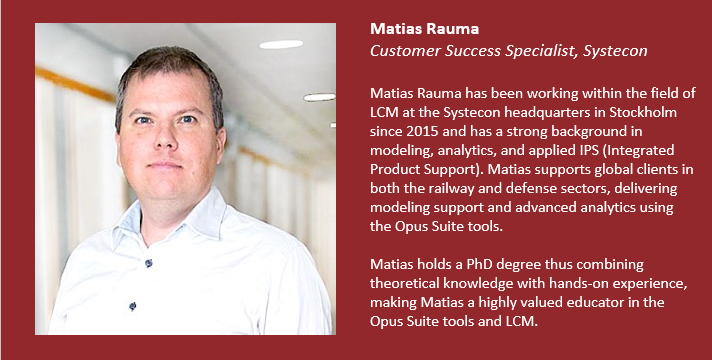

Amplifying Your Life Cycle Management Impact: from Analysis to Influence
Over nearly twenty years working with Life Cycle Management across rail and defense programs, I have seen brilliant analyses fall flat, sound recommendations ignored, and opportunities for major cost and availability improvements lost. The problem is rarely the analysis itself; it is influence.
Analysts and engineers do exceptional work, but if their insights never shape the real decisions, that effort only travels halfway. Time and again, the same patterns appear; good data, clear logic, yet limited impact, repeating across different organizations and projects. This article reflects on those experiences and explores how we can turn sound analysis into genuine influence.
From analysis to influence
Too often, Life Cycle Management (LCM) is seen as a technical exercise rather than a strategic discipline. Analysts deliver comprehensive studies full of numbers, models, and charts, but those results are sometimes left on the shelf while projects move ahead based on short-term pressures or narrowly defined objectives. The gap between analytical insight and actual decision-making is where so much potential value is lost.
Bridging that gap requires more than better models or more detailed data. It calls for a deliberate approach to influence, understanding when and how LCM analysis can shape decisions, budgets, and strategies. Over the years, certain patterns have emerged about what consistently works. These form the foundations for creating lasting impact.
Four foundations that change outcomes
Start early. The earlier LCM enters a program, the greater its influence. The first life cycle phase, the concept phase, is where functional requirements and support concepts are still flexible. Early involvement lets you define availability, and mission success alongside technical specifications to an estimated life cycle cost. That is where real leverage lies.
Sustain cost-effectiveness through life. Low life cycle cost and high availability are never automatic. They need continuous management across every life cycle phase. Build processes to review cost and availability periodically, using logistics decision support tools and integrated logistics support software to keep the picture current. When context or configuration changes, your guidance remains valid and trusted.
Be proactive, not reactive. Waiting for failures is expensive and demoralizing. Mission reliability modelling, maintenance modelling and simulation, and RAM (Reliability Availability Maintainability) analysis allow you to anticipate weak points, resource shortages, and downtime patterns before they happen. When you can forecast and prevent issues, analysis turns into a shield.
Elevate functional requirements. Technical compliance is measurable, but functional success is what matters. Treat targets such as availability, readiness, sortie rates, or turnaround times as part of the core requirements. Integrated product support tools and RAM analysis can help trace these outcomes back to design and support decisions, ensuring that operational needs guide engineering effort.
Why good analysis sometimes loses
A familiar pattern repeats across industries. A project faces several design options with different availability and LCC profiles. The analysis identifies one clear winner: slightly higher build cost but far higher uptime and lower total cost. The team delivers a confident recommendation, yet management chooses the design option with the lowest build cost.
The analysis is not wrong; the governance is. Many programs still measure success through the narrow lens of scope, cost, and time. Scope becomes purely technical, delivering to specification, cost means capex only, and time means building as fast as possible. There is no life-cycle view, no availability requirement, and no consideration of support cost or operational value.
When those are the constraints, the organization is optimized to pick the lowest up-front price, even when it guarantees decades of avoidable downtime. Analysts cannot change that outcome simply by improving charts; they have to change the frame in which the decision is made.
A playbook for turning analysis into influence
1) Make LCM the language of governance. Reframe the triple constraints in life-cycle terms.
- Scope, functional: Define what “done” means in operational terms such as mission capable hours, readiness, trains per hour, turnaround time, or sortie rate. Build technical conformance from that.
- Cost, LCC: Place life cycle cost on the same dashboard as capex. Use your tools to visualize how design, maintenance, and spares choices drive cost over decades.
- Time, life cycle: Track downtime and readiness through the full service period.
2) Tie every study to a decision. Start each analysis by identifying the decision it must support and when that decision will be made. For example, “Select maintenance concept A, B, or C by Q3; evaluate on availability, cost, and risk.” A support solution trade-off analysis framed this way is more likely to be used because its purpose is obvious.
3) Educate beyond the core team. Often the immediate project staff understand LCM; sponsors, procurement, and finance do not. Target them with short, tailored sessions. Teach finance about the cost of downtime and inventory carrying cost. Show sponsors how availability affects mission success. Help procurement write functional requirements into contracts. The aim is to remove weak links in the LCM chain so that awareness extends across the organization.
4) Quantify consequences in everyday terms. Translate technical metrics into vivid impacts. Say “five to seven years of total shutdown every forty years” instead of “reduced availability.” In defense programs, connect numbers to missed training days or reduced operational tempo. People act on what they can picture.
5) Bring inventory and maintenance economics forward. Readiness usually depends on spares and maintenance windows. Optimizing spare parts inventory through multi-echelon models and repair cycle analysis prevents mission aborts that appear random. Combine that with maintenance modelling and simulation to find the least disruptive intervention points. When leaders see the trade-off between stock, downtime, and cost clearly, they move from “cheapest” to “best value.”
6) Keep models simple and reasoning transparent. Use the simplest model that captures the real drivers. When complexity is needed, make the logic traceable: failure, repair, resource, availability, and mission effect.
7) Persist through pressure. Under schedule or budget stress, teams default to technical scope and short-term metrics. Keep the life-cycle view alive through regular LCC and availability check-ins. Influence requires repetition; change takes time.
Tools that enable influence
Integrated logistics support software, Defense Fleet Management Software, and Life Cycle Management for defense programs provide the backbone for this approach. Use mission reliability modelling to set functional targets. Use logistics decision support tools to link design and support choices to cost and availability. Integrated product support tools help push these insights into contracts and governance frameworks. The tools do not replace judgment; they amplify it by making trade-offs visible and defensible.
Turning analysis into real influence with Opus Suite
Applying these principles is far easier when supported by the right analytical environment. Opus Suite provides the structure and transparency needed to connect analysis with real-world decisions. It allows teams to model availability, optimise logistics support, and evaluate cost and performance trade-offs within one coherent framework.
By using Opus Suite, analysts can demonstrate not only which option performs best, but why and to what life cycle cost. It helps visualise the relationship between design choices, maintenance strategies, and life cycle costs in a way that decision-makers can easily grasp. The result is stronger analysis, clearer communication, and more influential recommendations.
Closing thoughts
Influence is not luck; it is designed. Get involved early. Define success in functional and life-cycle terms. Connect every analysis to a decision that matters. Educate not just analysts but every stakeholder. Keep your reasoning clear, your consequences concrete, and your patience intact.
Do that consistently and your analyses will not only be correct; they will be chosen.
Book a demo
Related Articles
- Optimizing Availability, Maintainability, and Cost for AMDR Using Opus Suite
- Decision Support in Early Phases: Driving Smarter System Procurement
- Applied Integrated Product Support (IPS) training courses
About the Author




